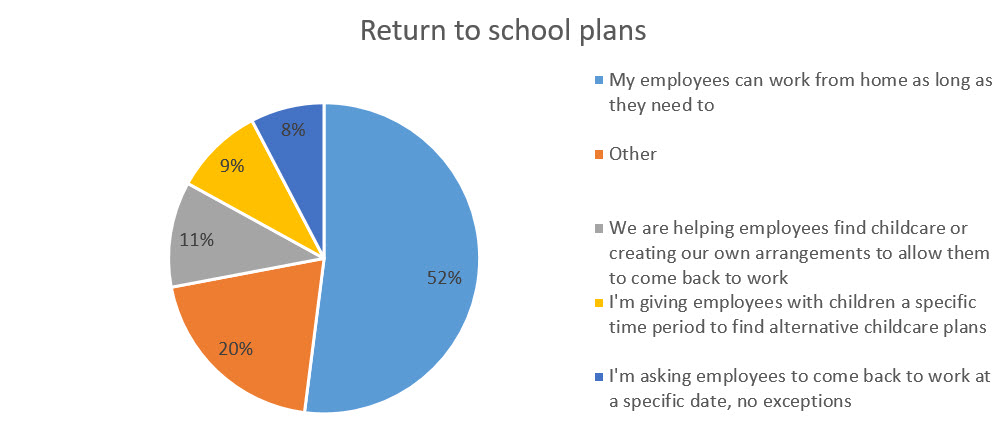An employers’ guide to accommodating working families

This fall, as schools reopen for distance learning, in-person learning or some combination of the two, business leaders are grappling with a new issue: how to accommodate employees with school-aged children while keeping their business running smoothly.
Return-to-school plans have different implications for CEOs, in part due to the nature of their business. If a business can only function if people work onsite, a CEO will have to decide how to manage an employee who can’t come to work because their children are learning at home. If a company can offer remote working, a CEO may need to provide better support mechanisms for employees juggling childcare, distance learning and work demands so they don’t burn out. A CEO might also have to debate whether to set strict workplace rules that apply to all employees or adapt rules according to the personal circumstances of individual employees.
These decisions carry legal implications, ethical issues and cultural risks, along with considerations around speed and scalability. They also raise a fundamental issue for CEOs: In the age of COVID-19, how does a leader balance what is right for their employees with what is right for their business? And what workplace policies support that balance?
What CEOs think about return-to-school plans
In August, Vistage surveyed 1,348 CEOs from small and midsize businesses about what return-to-school plans would mean for their business. Our analysis of the data reveals:
- Return-to-school plans are impacting businesses to varying degrees. More than half (57%) of CEOs surveyed said return-to-school plans would impact their business, while 14% said they were uncertain of the impact. Less than one-third of CEOs (29%) said school re-openings — or lack thereof — would have no impact on their business.
- Most businesses are not assisting employees with childcare arrangements. Only 11% of CEOs indicated they are helping employees find childcare or create arrangements that allow them to come back to work.
- Regardless of school plans, many companies are still offering remote working. More than half (52%) of CEOs surveyed said their employees can work from home as long as they need to.
- Some CEOs are taking a hardline approach. Of the CEOs we surveyed, 8% said they’ve given employees a hard date for returning to work, regardless of their personal circumstances or whether schools have reopened. In some cases, this is due to the nature of the business (e.g., the company can only run if people work onsite).

How to navigate three scenarios
In general, there are three return-to-school scenarios that are currently creating challenges for CEOs. Here are my recommendations for navigating those scenarios, informed by our survey data and insights from two HR experts.
CEO scenario 1: Your workforce is onsite, and your local schools are physically open.
- Create strict policies around safety. This situation puts your workforce at greater risk for contracting and spreading COVID-19. Safety should be your top concern. Follow CDC guidelines for social distancing, symptom checking and testing, and adapt work schedules to limit unnecessary contact between employees. Set clear guidelines for employees if they get sick or if they are caring for sick family members.
- Familiarize yourself with state laws. If you are requiring employees to return to work by a hard date, brush up on how to legally handle employees who cannot meet this deadline. Understanding state laws is important, especially if your business is not in an at-will state.
- Demonstrate flexibility and empathy. Taking a hardline approach to return-to-work may cause collateral damage to your culture and organization. If possible, look for alternate solutions that will help retain your best people. “The minute a company has the mindset of ‘You come back to the office or that’s it,’ they can destroy an awful lot of goodwill,” warns Sarah Grimstead, regional vice president of sales at Insperity.
- Prepare for employee losses. If you decide to furlough or let go of employees who do not meet attendance requirements, have a plan in place for replacing those employees so the business can function without overburdening other employees. However, before you make firing or furlough decisions, consider the opportunity costs involved — both in terms of the impact on other employees and the challenges involved in replacing workers.
CEO scenario 2: Your workforce is onsite, and your local schools are doing distance or hybrid learning.
- Rethink your workplace policies. For example, consider offering flexible hours or job sharing, and explore whether you can assist with childcare options. Develop and formalize these programs so you don’t have to spend time evaluating each employee’s situation on a case-by-case basis. “Could a business owner allow an individual to work a split shift from 6 a.m.-10 a.m., and then again from 5 p.m.-8 p.m.?” suggests Cynthia James, director of service operations at Insperity. “Does your organization allow employees to work on the weekends? Could an employee work an evening shift — say from 3 p.m. to 11 p.m. — when school is not in session? Our clients have come up with many ways to be flexible around employees’ family situations, especially when it comes to the care of children.”
- Communicate your plans verbally and in writing. If you intend to bring all employees back to the office by a certain date, make your plans explicitly clear. “We would recommend this is communicated in a live session, or possibly in a recorded session,” says James. “And we recommend that you follow that up with some form of written communication.”
- Abide by your legal responsibilities. Under the Families First Coronavirus Act (FFCA), certain accommodations for families are legally required, such as time off to care for children. Make sure you understand your company’s responsibilities in accordance with the FFCA.
- Consider learning pods. Learning pods give children a safe place to learn and play while their parents work. As a bonus, offering this option is a great way to differentiate your company and potentially attract top talent.
- Demonstrate sensitivity to employees with childcare issues. These employees are concerned about having resources so their children can thrive while having necessary supervision and care. “The importance of flexibility in the workplace is not a new concept by any means, but it’s taken on new importance in COVID-19,” says Grimstead. “The role of teacher and caregiver has never been more blended with parents’ work responsibilities than in the past few months. And I think this is especially true for women leaders.”
CEO scenario 3: Your employees are working remotely, and your local schools have reopened either virtually or physically.
- Be mindful of your employees’ bandwidth. Parents who are working from home while their children engage in distance learning have increased distractions from their new “co-workers.” In addition, they may run into technical problems as family members compete for internet or other technology.
- Look after your employees’ health and wellness. “Do not forget about your employees’ mental health,” says Grimstead. “This crisis is just beginning, and mental health is going to continue to become a problem as it goes on.” James recommends having regular one-on-one check ins with employees where you simply ask the question: “How are you doing?”
- Stay flexible and open to unconventional solutions. This approach could pay off dividends, as it may improve employee engagement and productivity. “One thing we know for sure is that the overall company benefit to accommodating some kind of flexible arrangement could increase your employee’s productivity,” says James. “And, more importantly, it could increase an employee’s loyalty to you personally, as a business owner or a leader, and even to your company.”
- Formalize your position. While evaluating situations on a case-by-case basis is a compassionate approach, failing to formalize your policies may cause some employees to question the fairness of their coworkers’ situation. In addition, this approach is not scalable or efficient.
Questions to anticipate
The unpredictability of COVID-19 means that even the best-laid plans may have to abruptly change at any time. To prepare for all possibilities, CEOs might consider questions such as: What’s the first thing I must do if my local schools suddenly close? If some of my employees can’t come to work, who can step in to replace them? How might I adapt certain roles so some employees can perform their jobs remotely? What will I do if an employee has to stay home because their son or daughter is sick?
No matter what happens, try to lead with empathy. As Michael C. Bush, CEO of Great Place to Work, once said: “Leaders must care the most, and focus on providing safety. Safety exists in three levels: emotional, psychological and physical safety. When safety is compromised, fear separates people into groups with similar fears. These silos not only stop innovation, but also restrict growth.”
Category: Talent Management
Tags: Challenging Times for Leadership, coronavirus, managing remote employees

